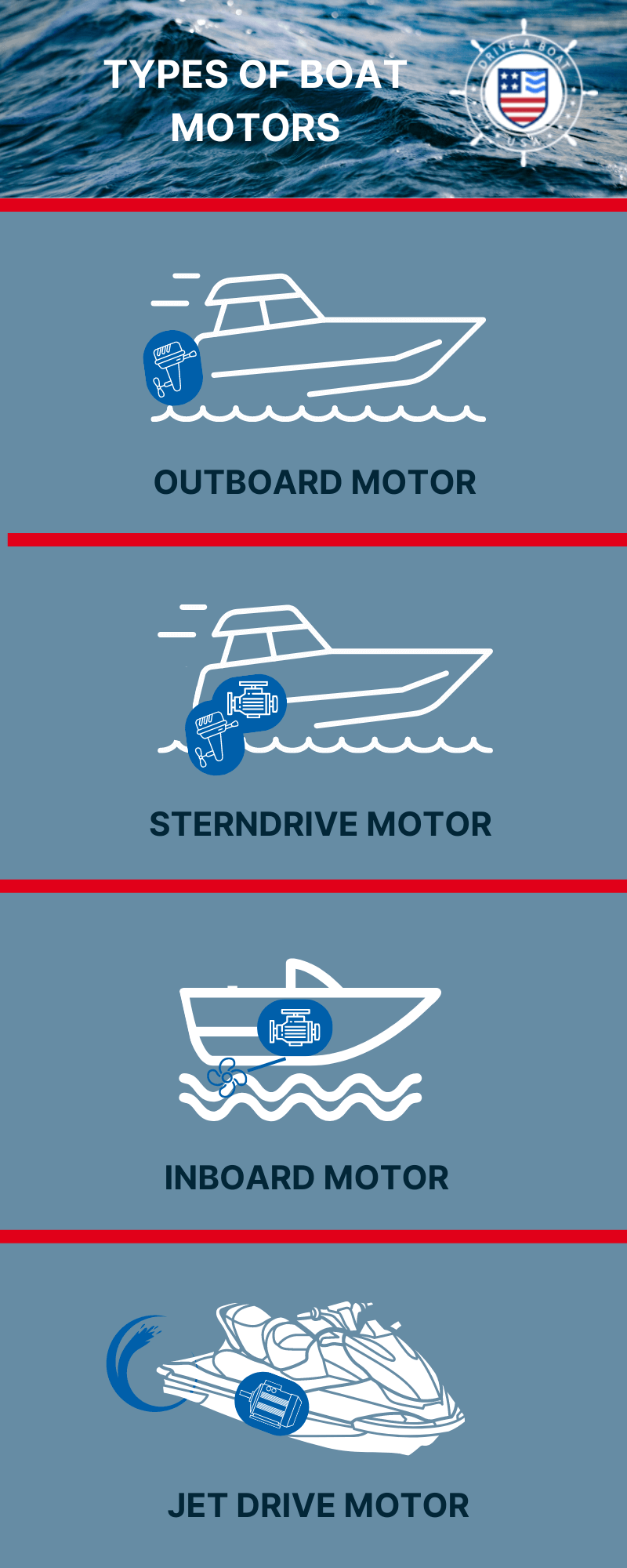Different Types of Boat Engines
Boat engines come in various shapes and sizes, but there are only four main types: inboard, outboard, sterndrive and jet drive.
It is important to choose the right type of propulsion system for your boat, as the weight and horsepower of the engine will affect boat performance. A motor that is not powerful enough for your boat will work too hard, and a motor that is too powerful could lead to dangerously high speeds.
Let’s take a look at the four major types of boat engines, and how best to use them.
Inboard motor
An inboard motor, also known as an inboard engine, is mounted within the hull of a watercraft, usually on vessels over 26 feet long. It typically consists of an internal combustion engine connected to a drive shaft, which transfers power to a propeller located outside the hull. Unlike an outboard motor, an inboard motor does not steer the boat.
The inboard motor is often positioned in the center or rear of the boat, providing stability and balance. These motors offer advantages such as increased fuel efficiency, better weight distribution, and reduced noise compared to outboard motors. They can be controlled from the boat’s helm through a system of levers, cables, or electronic controls, allowing for precise maneuverability. Since it is located inside the hull, it is protected against damage from underwater obstacles and the elements.
Outboard motor
An outboard motor is a self-contained propulsion system commonly used in small to medium-sized boats. Outboard motors are mounted externally on the stern or transom of the boat. They consist of a combustion engine, a gearbox, and a propeller.
Outboard motors are highly versatile and used in a variety of settings. They can be easily attached and detached, allowing for portability and convenience.
The engine in an outboard motor usually uses gasoline, though outboard motors also include electric (trolling) motors, gasoline-and-oil mixture 2-stroke engines and diesel engines. Controls for steering, throttle, and gear shifting are located on the motor’s tiller or a remote control panel, providing the operator with direct control over speed and direction.
Outboard motors are known for their maneuverability, making them ideal for activities such as fishing, recreational boating, and water sports. They offer excellent steering response and can quickly change direction, allowing for precise maneuvering in tight spaces.
Sterndrive
A sterndrive motor, also known as an inboard/outboard (I/O) motor, combines elements of both inboard and outboard motors. It is a propulsion system commonly used in recreational boats.
The sterndrive motor features an inboard engine positioned inside the boat that is connected to a drive unit that extends outside the transom. This drive unit includes a gearbox, a vertical driveshaft, and a propeller. The outside potion of the motor swivels to allow the skipper to steer the boat. A sterndrive engine relies on a four-stroke automotive engine for power.
The motor’s location provides improved weight distribution and frees up space within the boat. Sterndrive motors offer excellent maneuverability and can be tilted or trimmed for shallow water operation. They can be powered by either gasoline or diesel, and are used more often than outboard motors on large motorboats as they are more powerful.
Jet Drive
A jet drive engine, also known as a jet propulsion system, is often used on personal watercraft (PWC) and jet boats.
Unlike traditional propeller-based propulsion systems, a jet drive engine uses a powerful water pump to draw water in and forcefully expel it through a nozzle at the stern. The high-speed jet of water propels the boat forward.
Jet drive engines cannot be used in shallow water. When used under the right conditions, they do offer good maneuverability, and reduced risk of damage from underwater obstacles. They also make it less likely to damage people or marine life in the water, though swimmers and boat operators should always stay clear of the jet pump. A jet-driven watercraft loses all steering capabilities when the power is off.
They require regular maintenance of the intake grate, impeller, and steering components for optimal performance.
Find out which type of engine is right for your watercraft with Drive a Boat USA!
There are four types of boat engines for a reason: each type has different operating limitations, advantages and capabilities.
If you are a first-time boat owner or you are looking to replace the motor on your vessel, it’s worth taking the time to learn which type of propulsion system will work best for your specific watercraft.
Drive a Boat USA offers official online state-approved boat safety courses which you can complete from the comfort of your home.


